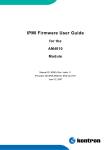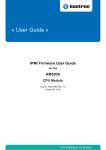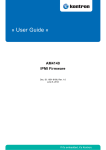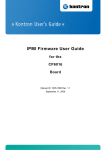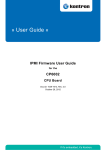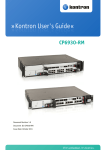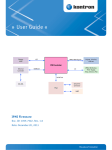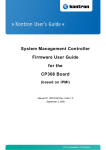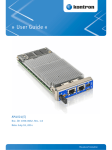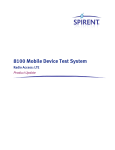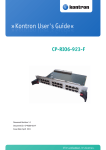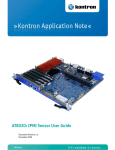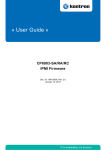Download AM4001 IPMI: MMC User Manual
Transcript
IPMI Firmware User Guide for the AM4100 Module Manual ID: 36725 Rev. Index 1.0 Firmware: SK-IPMI-AM4100, EKS Idx 0100 October 15, 2007 IPMI Firmware User Guide 1. AM4100 Copyright Copyright © 2007 Kontron AG Kontron Modular Computers makes no representations or warranties with respect to the contents or use of this manual, and specifically disclaims any express or implied warranties of merchantability or fitness for any particular purpose. Kontron Modular Computers makes no representations or warranties with respect to this embedded Linux package, and specifically disclaims any express or implied warranties of merchantability or fitness for any particular purpose. Permission is granted to make and distribute verbatim copies of this manual provided that the copyright notice and this permission notice are preserved on all copies. Permission is granted to copy and distribute modified versions of this documentation under the conditions for verbatim copying, provided also that the entire resulting derived work is distributed under the terms of a permission notice identical to this one. Permission is granted to copy and distribute translations of this documentation into another language, under the above conditions for modified versions. The PICMG® and CompactPCI® names and the PICMG®, CompactPCI®, ATCA®, and AdvancedTCA® logos are registered trademarks and AdvancedMC is a trademark of the PCI Industrial Computer Manufacturers Group. Intel is a registered trademark of Intel Corporation. I2C is a trademark of Phillips Semiconductors. Linux is a registered trademark of Linus Torvalds. All other trademarks, registered trademarks, and trade names are the property of their respective owners. Page 2 © 2007 Kontron AG ID 36725, Rev. 1.0 AM4100 2. IPMI Firmware User Guide Revision History Manual/Product Title: IPMI Firmware User Guide for the AM4100 Module Manual ID Number: 36725 Revision Index Brief Description of Changes Date of Issue 1.0 Initial Issue Oct. 15, 2007 Imprint Kontron Modular Computers GmbH may be contacted via the following: MAILING ADDRESS TELEPHONE AND E-MAIL Kontron Modular Computers GmbH +49 (0) 800-SALESKONTRON Sudetenstraße 7 [email protected] D - 87600 Kaufbeuren Germany For further information about other Kontron products, please visit our Internet web site: www.kontron.com Disclaimer Copyright © 2007 Kontron AG. All rights reserved. All data is for information purposes only and not guaranteed for legal purposes. Information has been carefully checked and is believed to be accurate; however, no responsibility is assumed for inaccuracies. Kontron and the Kontron logo and all other trademarks or registered trademarks are the property of their respective owners and are recognized. Specifications are subject to change without notice. ID 36725, Rev. 1.0 © 2007 Kontron AG Page 3 IPMI Firmware User Guide 3. AM4100 Contents 1. Copyright ........................................................................................................................... 2 2. Revision History ................................................................................................................ 3 3. Contents ............................................................................................................................. 4 4. Introduction........................................................................................................................ 6 5. 6. 7. 8. 4.1 Acronym Definitions.................................................................................................. 6 4.2 Related Documentation.............................................................................................. 7 Introduction........................................................................................................................ 8 5.1 IPMI in AdvancedMC / AdvancedTCA Environment .............................................. 8 5.2 Module Management Controller Hardware ............................................................... 8 MMC Firmware ................................................................................................................. 9 6.1 Key Features .............................................................................................................. 9 6.2 Supported IPMI Commands .................................................................................... 10 6.2.1 Standard Commands ........................................................................................ 10 6.2.2 OEM Commands and Extensions .................................................................... 17 6.2.2.1 Get Device ID Command with OEM Extensions .................................... 17 6.2.2.2 Set Firmware Parameters ......................................................................... 18 6.2.2.3 Set Control State (Firmware Hub, Boot Order) ....................................... 19 6.2.2.4 Get Control State (Firmware Hub, Boot Order) ...................................... 20 6.2.2.5 Set or Get FRU Sub Device Number ....................................................... 21 6.2.2.6 OEM Module Quiescence Feedback........................................................ 22 Sensors Implemented on the AM4100............................................................................. 24 7.1.1 Sensor List ....................................................................................................... 25 7.1.2 OEM Event / Reading Types ........................................................................... 28 Firmware Code................................................................................................................. 30 8.1 Structure and Functionality...................................................................................... 30 8.2 Firmware Upgrade ................................................................................................... 30 8.3 Firmware / Module Identification............................................................................ 31 8.4 FRU Information...................................................................................................... 31 8.4.1 Structure and Functionality.............................................................................. 31 8.4.2 Board Specific FRU Data Organization........................................................... 32 8.4.3 Download ......................................................................................................... 32 Page 4 © 2007 Kontron AG ID 36725, Rev. 1.0 AM4100 IPMI Firmware User Guide 8.5 E-Keying...................................................................................................................32 8.6 PCI Express Clock Source........................................................................................33 9. NetBootLoader Flash Selection........................................................................................34 9.1.1 Boot Flash Selection by OEM IPMI Command...............................................34 9.1.2 Automatic Boot Flash Selection during the Boot Process................................34 10. Hot Swap ......................................................................................................................35 11. Module Not Running on an ATCA Carrier..................................................................36 12. OS Support / Tools .......................................................................................................37 12.1.1 13. Linux.................................................................................................................37 IPMI Communication LEDs.........................................................................................38 ID 36725, Rev. 1.0 © 2007 Kontron AG Page 5 IPMI Firmware User Guide 4. Introduction 4.1 Acronym Definitions AMC BSP DMI FRU FWH I2C IPMB IPMB-0 IPMB-L IPMC IPMI IOL KCS MMC MP PICMG PWR SDR SDRR SEL SMBIOS SMS SOL Page 6 AM4100 Advanced Mezzanine Card Board Support Package Desktop Management Interface Field Replaceable Unit Firmware Hub Inter-Integrated Circuit Intelligent Platform Management Bus AdvancedTCA shelf-level IPMB Local, on-carrier IPMB that links the carrier IPMC with the MMCs of installed modules Intelligent Platform Management Controller located on AMC carrier Intelligent Platform Management Interface IPMI over LAN. An MMC is accessed via LAN, not IPMB Keyboard Controller Style Module Management Controller – an IPMI controller located on the AMC module Management Power PCI Industrial Computer Manufacturer Group Payload Power Sensor Data Record Sensor Data Record Repository System Event Log System Management BIOS System Management Software (designed to run under the OS) Serial over LAN. A serial interface is redirected by LAN using the RMCP+ protocol. © 2007 Kontron AG ID 36725, Rev. 1.0 AM4100 4.2 IPMI Firmware User Guide Related Documentation IPMI specifications: (http://www.intel.com/design/servers/ipmi/spec.htm) • IPMI-Intelligent Platform Management Interface Specification. Second Generation v2.0, February 12, 2004 (part) • [2] IPMI- Platform Management FRU Information Storage Definition v1.0, Document Revision 1.1, September 1999 PICMG specifications: http://www.picmg.org • PICMG® AMC.0 R1.0 - Advanced Mezzanine Card Base Specification • PICMG® AMC.1 R1.0 - PCI Express and Advanced Switching on AdvancedMC • PICMG® AMC.2 R1.0 – AMC Gigabit Ethernet/10 Gigabit XAUI Ethernet Open tools documentation • [1] Ipmitool documentation: http://ipmitool.sourceforge.net • OpenIPMI documentation: http://www.openipmi.sourceforge.net Kontron manuals and specifications: http://www.kontron.com/ • AM4100 User’s Guide • [3] AM4100 Linux Board Support Package As a hot-swappable field replaceable unit (FRU), the AM4100 follows the stringent carrier grade RASM feature set, namely - Reliability, Availability, Serviceability, Maintainability. Built in accordance to the AMC.0 specification, the AM4100 is also AMC.1 and AMC.2 compliant and is easily managed via IPMI v1.5/v2.0. As with every Advanced Mezzanine Card (AMC) the AM4100 is equipped with a Module Management Controller (MMC). ID 36725, Rev. 1.0 © 2007 Kontron AG Page 7 IPMI Firmware User Guide AM4100 5. Introduction 5.1 IPMI in AdvancedMC / AdvancedTCA Environment The Module Management Controller is a crucial component of any AMC module. Besides acting as a regular IPMI management controller (sensor monitoring, event logging, etc.), it also provides an interface to all necessary data related to module power requirements and implemented interfaces (E-Keying). Further, it plays an active role in the module hot swap state management. The carrier IPMI Controller (IPMC) communicates with the MMC using the local IPMB (IPMB-L) bus. In an ATCA/AMC environment, it is the IPMC that actually turns on/off module (payload) power. However, before the IPMC enables the module payload power, various criteria must be satisfied by both the carrier and the module, including power requirements and capabilities, matching interfaces, current module hot swap state, and any other special conditions as specified by the Shelf Manager policy. 5.2 Module Management Controller Hardware On the AM4100 module, the MMC is implemented using the Renesas H8S/2166 controller with 512 kB of internal flash and 40 kB of RAM. An additional 1 MB serial EEPROM chip provides redundant firmware image storage. A separate 32 kB serial EEPROM chip is used for firmware private data and 4 kB FRU Inventory storage. The MMC circuit implements two local Keyboard Style Interfaces (KCS) with interrupt support for communication with system side management software and the IPMB-L bus for interconnection with the IPMC. The MMC implements a wide range of sensors that permit the monitoring of: Page 8 • main power voltages: +12V (PWR), +5V, +3.3V, +3.3V (MP), +1.5V, +1.8V, +0.9V (DDR) , +1.1V • temperatures: CPU die, board inlet and outlet near CPU, board inlet and outlet near AMC connector • Power Good, IPMB link, board reset, post code, boot error, processor hot detection (>105 °C), IPMB-L state, Health error, IPMI watchdog etc. © 2007 Kontron AG ID 36725, Rev. 1.0 AM4100 6. MMC Firmware 6.1 Key Features IPMI Firmware User Guide • compliant with the related IPMI and PICMG® specifications (refer to 4.2, Related Documentation) • firmware designed and specially made for AdvancedMC environments • supports two KCS interfaces with interrupt support • supports the local IPMB (IPMB-L) interface • out of band management and monitoring using IPMB-L interface permits access to sensors regardless of module CPU state • sensor thresholds fully configurable • sensor names prefixed with AMC module Bay ID (A1…4, B1…4) • Usable in µTCA slots 1…12. Sensor names for slots 9…12 are prefixed with R9…R12 • complete IPMI watchdog functionality • complete FRU functionality (refer to 8.4) • firmware can be updated in the field (refer to 8.2) • two firmware banks implemented, firmware bank management is done by the open tool ipmitool (function fwum) [1] (refer to 8.1) • downloading new firmware image does not break currently running firmware activities (refer to 8.2). • manual and automatic firmware image roll-back (in case of upgrade failure). Refer to 8.2. • firmware customizable per boot loader or per OEM IPMI commands • interoperable with other AMC, ATCA, or IPMI solutions • OEM board supervision and control extensions such as boot device flash selection and firmware boot order configuration (refer to 6.2.2) • Boot loader supervisor and automated switch to recover the boot image from a second boot device flash (refer to 9) • Graceful shutdown support (refer to 10) • “Health” LED shows heartbeat and pulses if a KCS interface is active. The “outof-service” (OOS) LED pulses when IPMB-L is active (refer to 13). • If the carrier supplies an external clock 3 the module will use it. Otherwise the module will use the internal PCIe clock (refer to 8.6). ID 36725, Rev. 1.0 © 2007 Kontron AG Page 9 IPMI Firmware User Guide 6.2 AM4100 Supported IPMI Commands 6.2.1 Standard Commands Part of the command list in IPMI specification 2.0 M = mandatory, O = optional IPMI 2.0 Spec. section NetFn CMD Kontron support On MMC IPM Device “Global” Commands Get Device ID M 20.1 App 01h M / Yes [3] Cold Reset 20.2 App 02h O / Yes Warm Reset 20.3 App 03h O / No Get Self Test Results 20.4 App 04h O / Yes Manufacturing Test On 20.5 App 05h O / No Set ACPI Power State 20.6 App 06h O / No Get ACPI Power State 20.7 App 07h O / No Get Device GUID 20.8 App 08h O / No Broadcast “Get Device ID” 20.9 App 01h M / Yes BMC Watchdog Timer Commands O Reset Watchdog Timer 27.5 App 22h O / Yes Set Watchdog Timer 27.6 App 24h O / Yes Get Watchdog Timer 27.7 App 25h O / Yes Page 10 © 2007 Kontron AG ID 36725, Rev. 1.0 AM4100 IPMI Firmware User Guide BMC Device and Messaging Commands O Set BMC Global Enables 22.1 App 2Eh O / Yes Get BMC Global Enables 22.2 App 2Fh O / Yes Clear Message Flags 22.3 App 30h O / Yes Get Message Flags 22.4 App 31h O / Yes Enable Message Channel Receive 22.5 App 32h O / Yes Get Message 22.6 App 33h O / Yes Send Message 22.7 App 34h O / Yes Read Event Message Buffer 22.8 App 35h O / Yes Get BT Interface Capabilities 22.9 App 36h O / Yes Get System GUID 22.14 App 37h O / No Get Channel Authentication Capabilities 22.13 App 38h O / Yes Get Session Challenge 22.15 App 39h O / Yes Activate Session 22.17 App 3Ah O / Yes Set Session Privilege Level 22.18 App 3Bh O / Yes Close Session 22.19 App 3Ch O / Yes Get Session Info 22.20 App 3Dh O / Yes Get AuthCode 22.21 App 3Fh O / No Set Channel Access 22.22 App 40h O / Yes Get Channel Access 22.23 App 41h O / Yes Get Channel Info 22.24 App 42h O / Yes Set User Access 22.26 App 43h O / Yes Get User Access 22.27 App 44h O / Yes Set User Name 22.28 App 45h O / Yes Get User Name 22.29 App 46h O / Yes Set User Password 22.30 App 47h O / Yes Activate Payload 24.1 App 48h O / Yes Deactivate Payload 24.2 App 49h O / Yes Get Payload Activation Status 24.4 App 4Ah O / Yes Get Payload Instance Info 24.5 App 4Bh O / Yes Set User Payload Access 24.6 App 4Ch O / Yes Get User Payload Access 24.7 App 4Dh O / Yes Get Channel Payload Support 24.8 App 4Eh O / Yes Get Channel Payload Version 24.9 App 4Fh O / Yes Get Channel OEM Payload Info 24.10 App 50h O / No Master Write-Read 22.11 App 52h O / Yes Get Channel Cipher Suits 22.15 App 54h O / No Suspend/Resume Payload Encryption 24.3 App 55h O / Yes Set Channel Security Keys 22.25 App 56h O / No Get System Interface Capabilities 22.9 App 57h O / No ID 36725, Rev. 1.0 © 2007 Kontron AG Page 11 IPMI Firmware User Guide AM4100 Chassis Device Commands O / Yes Get Chassis Capabilities 28.1 Chassis 00h O / Yes Get Chassis Status 28.2 Chassis 01h O / Yes Chassis Control 28.3 Chassis 02h O / No Chassis Reset 28.4 Chassis 03h O / No Chassis Identify 28.5 Chassis 04h O / No Set Chassis Capabilities 28.7 Chassis 05h O / No Set Power Restore Policy 28.8 Chassis 06h O / No Get System Restart Cause 28.11 Chassis 07h O / No Set System Boot Options 28.12 Chassis 08h O / No Get System Boot Options 28.13 Chassis 09h O / No Get POH Counter 28.14 Chassis 0Fh O / Yes [1] Event Commands M Set Event Receiver 29.1 S/E 01h M / Yes Get Event Receiver 29.2 S/E 02h M / Yes Platform Event (a.k.a. “Event Message”) 29.3 S/E 03h M / Yes PEF and Alerting Commands O Get PEF Capabilities 30.1 S/E 10h O / No Arm PEF Postpone Timer 30.2 S/E 11h O / No Set PEF Configuration Parameters 30.3 S/E 12h O / No Get PEF Configuration Parameters 30.4 S/E 13h O / No Set Last Processed Event ID 30.5 S/E 14h O / No Get Last Processed Event ID 30.6 S/E 15h O / No Alert Immediate 30.7 S/E 16h O / No PET Acknowledge 30.8 S/E 17h O / No Page 12 © 2007 Kontron AG ID 36725, Rev. 1.0 AM4100 IPMI Firmware User Guide Sensor Device Commands M Get Device SDR Info 35.2 S/E 20h M / Yes Get Device SDR 35.3 S/E 21h M / Yes Reserve Device SDR Repository 35.4 S/E 22h M / Yes Get Sensor Reading Factors 35.5 S/E 23h O / No Set Sensor Hysteresis 35.6 S/E 24h O / Yes Get Sensor Hysteresis 35.7 S/E 25h O / Yes Set Sensor Threshold 35.8 S/E 26h O / Yes Get Sensor Threshold 35.9 S/E 27h O / Yes Set Sensor Event Enable 35.10 S/E 28h O / Yes Get Sensor Event Enable 35.11 S/E 29h O / Yes Re-arm Sensor Events 35.12 S/E 2Ah O / No Get Sensor Event Status 35.13 S/E 2Bh O / No Get Sensor Reading 35.14 S/E 2Dh M / Yes Set Sensor Type 35.15 S/E 2Eh O / No Get Sensor Type 35.16 S/E 2Fh O / No FRU Device Commands M Get FRU Inventory Area Info 34.1 Storage 10h M / Yes Read FRU Data 34.2 Storage 11h M / Yes Write FRU Data 34.3 Storage 12h M / Yes SDR Device Commands O Get SDR Repository Info 33.9 Storage 20h O / No Get SDR Repository Allocation Info 33.10 Storage 21h O / No Reserve SDR Repository 33.11 Storage 22h O / No Get SDR 33.12 Storage 23h O / No Add SDR 33.13 Storage 24h O / No Partial Add SDR 33.14 Storage 25h O / No Delete SDR 33.15 Storage 26h O / No Clear SDR Repository 33.16 Storage 27h O / No Get SDR Repository Time 33.17 Storage 28h O / No Set SDR Repository Time 33.18 Storage 29h O / No Enter SDR Repository Update Mode 33.19 Storage 2Ah O / No Exit SDR Repository Update Mode 33.20 Storage 2Bh O / No Run Initialization Agent 33.21 Storage 2Ch O / No ID 36725, Rev. 1.0 © 2007 Kontron AG Page 13 IPMI Firmware User Guide AM4100 SEL Device Commands O Get SEL Info 40.2 Storage 40h Get SEL Allocation Info 40.3 Storage 41h O / No Reserve SEL 40.4 Storage 42h O / No Get SEL Entry 40.5 Storage 43h O / No Add SEL Entry 40.6 Storage 44h O / No Partial Add SEL Entry 40.7 Storage 45h O / No Delete SEL Entry 40.8 Storage 46h O / No Clear SEL 40.9 Storage 47h O / No Get SEL Time 40.10 Storage 48h O / No Set SEL Time 40.11 Storage 49h O / No Get Auxiliary Log Status 40.12 Storage 5Ah O / No Set Auxiliary Log Status 40.13 Storage 5Bh O / No LAN Device Commands O / No O Set LAN Configuration Parameters 23.1 Transport 01h O / Yes Get LAN Configuration Parameters 23.2 Transport 02h O / No Suspend BMC ARPs 23.3 Transport 03h O / Yes Get IP/UDP/RMCP Statistics 23.4 Transport 04h O / Yes Serial/Modem Device Commands O Set Serial/Modem Configuration 25.1 Transport 10h O / No Get Serial/Modem Configuration 25.2 Transport 11h O / No Set Serial/Modem Mux 25.3 Transport 12h O / No Get TAP Response Codes 25.4 Transport 13h O / No Set PPP UDP Proxy Transmit Data 25.5 Transport 14h O / No Get PPP UDP Proxy Transmit Data 25.6 Transport 15h O / No Send PPP UDP Proxy Packet 25.7 Transport 16h O / No Get PPP UDP Proxy Receive Data 25.8 Transport 17h O / No Serial/Modem Connection Active 25.9 Transport 18h O / No Callback 25.10 Transport 19h O / No Set User Callback Options 25.11 Transport 1Ah O / No Get User Callback Options 25.12 Transport 1Bh O / No SOL Activating 26.1 Transport 20h O / Yes Get SOL Configuration Parameters 26.2 Transport 21h O / Yes Set SOL Configuration Parameters 26.3 Transport 22h O / Yes Page 14 © 2007 Kontron AG ID 36725, Rev. 1.0 AM4100 IPMI Firmware User Guide Bridge Management Commands (ICMB) O Get Bridge State [ICMB] Bridge 00h O / No Set Bridge State [ICMB] Bridge 01h O / No Get ICMB Address [ICMB] Bridge 02h O / No Set ICMB Address [ICMB] Bridge 03h O / No Set Bridge Proxy Address [ICMB] Bridge 04h O / No Get Bridge Statistics [ICMB] Bridge 05h O / No Get ICMB Capabilities [ICMB] Bridge 06h O / No Clear Bridge Statistics [ICMB] Bridge 08h O / No Get Bridge Proxy Address [ICMB] Bridge 09h O / No Get ICMB Connector Info [ICMB] Bridge 0Ah O / No Get ICMB Connection ID [ICMB] Bridge 0Bh O / No Send ICMB Connection ID [ICMB] Bridge 0Ch O / No Discovery Commands (ICMB) O Prepare For Discovery [ICMB] Bridge 10h O / No Get Addresses [ICMB] Bridge 11h O / No Set Discovered [ICMB] Bridge 12h O / No Get Chassis Device ID [ICMB] Bridge 13h O / No Set Chassis Device ID [ICMB] Bridge 14h O / No Bridging Commands (ICMB) O Bridge Request [ICMB] Bridge 20h O / No Bridge Message [ICMB] Bridge 21h O / No Event Commands (ICMB) O Get Event Count [ICMB] Bridge 30h O / No Set Event Destination [ICMB] Bridge 31h O / No Set Event Reception State [ICMB] Bridge 32h O / No Send ICMB Event Message [ICMB] Bridge 33h O / No Get Event Destination [ICMB] Bridge 34h O / No Get Event Reception State [ICMB] Bridge 35h O / No OEM Commands for Bridge NetFn OEM Commands O [ICMB] Bridge C0h-FEh Other Bridge Commands Error Report ID 36725, Rev. 1.0 O / No O [ICMB] Bridge FFh © 2007 Kontron AG O / No Page 15 IPMI Firmware User Guide AM4100 AdvancedTCA®[10] PICMG® 3.0 Table Get PICMG Properties 3-9 PICMG 00h M / Yes Get Address Info 3-8 PICMG 01h N/A Get Shelf Address Info 3-13 PICMG 02h N/A Set Shelf Address Info 3-14 PICMG 03h N/A FRU Control 3-22 PICMG 04h Get FRU LED Properties 3-24 PICMG 05h M / Yes [2] M / Yes Get LED Color Capabilities 3-25 PICMG 06h M / Yes Set FRU LED State 3-26 PICMG 07h M / Yes Get FRU LED State 3-27 PICMG 08h M / Yes Set IPMB State 3-51 PICMG 09h N/A Set FRU Activation Policy 3-17 PICMG 0Ah N/A Get FRU Activation Policy 3-18 PICMG 0Bh N/A Set FRU Activation 3-16 PICMG 0Ch N/A Get Device Locator Record ID 3-29 PICMG 0Dh M / Yes Set Port State 3-41 PICMG 0Eh N/A Get Port State 3-42 PICMG 0Fh N/A Compute Power Properties 3-60 PICMG 10h N/A Set Power Level 3-62 PICMG 11h N/A Get Power Level 3-61 PICMG 12h N/A Renegotiate Power 3-66 PICMG 13h N/A Get Fan Speed Properties 3-63 PICMG 14h N/A Set Fan Level 3-65 PICMG 15h N/A Get Fan Level 3-64 PICMG 16h N/A Bused Resource 3-44 PICMG 17h N/A Get IPMB Link Info 3-49 PICMG 18h N/A AMC Set AMC Port State AMC.0 Table Table 3-27 PICMG 19h O / Yes Get AMC Port State Table 3-28 PICMG 20h O / Yes M [1] Response byte 2: hours, byte 3: minutes after module start. Bytes 4..6: void [2] Request byte 3: = only 04h (quiesced) implemented. [3] Has oem extensions. Please refer to 6.2.2.1, Get Device ID Command with OEM Extensions Page 16 © 2007 Kontron AG ID 36725, Rev. 1.0 AM4100 IPMI Firmware User Guide 6.2.2 OEM Commands and Extensions 6.2.2.1 Get Device ID Command with OEM Extensions LUN Get Device ID command with OEM extensions Byte 00h NetFn App = 06h CMD 01h Data Field Request Data - - Response Data 1 Completion Code 2:12 Regular Get Device ID Command response fields ID 36725, Rev. 1.0 13 Release index (e.g. 101 denotes release index 1.01) Please note: Some tools offer this as “SDR version”. 14 Module Geographical Address (site number): 1 … 8 = Module in AMC bay A1, A2 ,A3, A4, B1, B2, B3, B4 or in µTCA slot 1 … 8 with bus addresses 72h, 74h, 76h, 78h, 7ah, 7ch, 7eh, 80h 9 …12 = Module in µTCA slot 9 … 12 with bus addresses 82h, 84h, 86h,88h 0, > 12 = Module position is not in range. The IPMB-L bus is switched off (ref. to 8.3). 15 Reserved 16 Reserved © 2007 Kontron AG Page 17 IPMI Firmware User Guide AM4100 6.2.2.2 Set Firmware Parameters The command below permits the selection of interrupts to be used during KCS communication. LUN Set Firmware Parameters Request data Response data Page 18 03h Byte Data Field 1 Reserved B4h 2 Reserved 90h 3 Reserved 91h 4 Reserved 8Bh 5 Cmd Flags [6:2] Reserved [1] 0b = get only [0] 0b = do not reset 6 Operating Modes [7:5] Reserved [4] Reserved [3:1] Reserved [0] Reserved (=1b) 7 IRQ number FFh = do not use interrupts 0Ah = use IRQ10 0Bh = use IRQ11 Any other values Reserved. 1 Completion code 2 Cmd Flags 3 Operating Modes 4 IRQ number © 2007 Kontron AG NetFn CMD OEM = 3Eh 05h ID 36725, Rev. 1.0 AM4100 IPMI Firmware User Guide 6.2.2.3 Set Control State (Firmware Hub, Boot Order) LUN Set Control State (Firmware Hub, Boot Order) Byte Request data 00h NetFn OEM = 3Eh CMD 20h Data Field 1 Control ID 00h: MMC Flash selection 9Dh: Firmware Boot Order Configuration 2 Control State for MMC Flash selection: (These settings are stored in EEPROM and applied (to logic) each time the MMC detects power-on) 00h = Flash selection by switch is not inverted 01h = Flash selection by switch is logically inverted Please note that this selection will be automatically toggled during a failing boot process. Other settings may additionally modify Control State for Boot Order Configuration: 00h .. FFh = Selected Boot Order Configuration being defined for the Net Boot Loader (refer to the Net Boot Loader documentation).. (These settings are stored in EEPROM and applied (to logic) each time the MMC detects power-on) Response data ID 36725, Rev. 1.0 1 Completion code © 2007 Kontron AG Page 19 IPMI Firmware User Guide AM4100 6.2.2.4 Get Control State (Firmware Hub, Boot Order) LUN Get Control State (Firmware Hub, Boot Order) Byte 00h NetFn CMD OEM = 3Eh Data Field Request data 1 Control ID 00h Firmware MMC Flash selection 9Dh Firmware Boot Order Configuration Response data 1 Completion code 2 Current Control State (refer to 6.2.2.3, Set Control State (Firmware Hub, Boot Order) Page 20 21h © 2007 Kontron AG ID 36725, Rev. 1.0 AM4100 IPMI Firmware User Guide 6.2.2.5 Set or Get FRU Sub Device Number For the specific organization of the AM4100’s FRU data in sub devices refer to 8.4.2, Board Specific FRU Data Organization. For e.g. FRU data updates it is possible to temporarily override the internal FRU sub device selection by the OEM command below. Every time when officially FRU 0 data is accessed in reality the data of the selected sub device is accessed. LUN Set or Get FRU Sub Device Number Byte 00h NetFn OEM = 3Eh CMD 22h Data Field Request data 1 Sub device number 00h…03h: Set these numbers to select the FRU 0 sub devices 0…3. 0xFE: Set this code to get the number of the currently selected FRU 0 sub device. 0xFF: Set this code to reset the number of the currently selected FRU 0 sub device to the hardware settings (Dip switch or solder jumper, refer to the hardware manual). Response data 1 Currently selected FRU 0 sub device number Please note: This command selects only the storage of the currently used FRU data and NOT the board’s operation mode! Settings changed with this command are volatile and only valid until the next reset of the MMC. Example: If you want to update the FRU data memory for mode 1, PCIe End Point you should proceed like this: • Use the OEM command ‘Set or Get FRU Sub Device Num’ and select sub device 1. • Use ipmitool [1] to write the FRU data via FRU 0: ‘ipmitool fru write 0 <filename>’ • Use the OEM command ‘Set or Get FRU Sub Device Num’ and select sub device 0xff to re-activate the default sub device again. ID 36725, Rev. 1.0 © 2007 Kontron AG Page 21 IPMI Firmware User Guide AM4100 6.2.2.6 OEM Module Quiescence Feedback Overview: Please refer to: 10. Hot Swap This command provides support to control a graceful shut down of the AM4100. There is a Graceful Reboot and Shutdown Daemon (grnsd) for Linux included in the Linux BSPs being offered by Kontron. It works as described in the following (refer to “Usage for a self written shut down daemon” below). Usage for a self written shut down daemon: This command normally is used during a shut down to inform the MMC about the end of shutdown. If a timeout time must be set to avoid endless waiting for the end of payload shutdown, then the daemon sets this timeout in the command after system start with the “set quiesce wait timeout” bit set and the “Quiesce wait timeout” time <> 0. Afterwards the daemon has to call this command cyclically with the “OS daemon present” bit set. When the MMC gets a FRU Control (Quiesce) request from the carrier (e.g. during a Hot Swap sequence) it sets the “quiesce request (FRU Control)” bit in its command response. After the daemon sees this bit set in the response it should shut down the system. After having set the “quiesce request (FRU Control)” bit the MMC starts the timeout timer (if a timeout time was defined) and monitors the sleep signal line to recognize the sleep state which should be caused by the shut down. When the MMC receives a command with the “quiescence acknowledge” bit set or the timeout timer has expired, the MMC sends a “Module Hot Swap event” message to the carrier, and in the following the payload power will be switched off. If no daemon is announced as present: If no command call announces that a daemon is present, the MMC automatically uses the default wait timeout time 0 (endless wait) during the Hot Swap process until the daemon sends the “Os ready” using control bits = 40h (see below). But if the wait timeout time was set to a value 1…255 by control bits = 80h (see below) this wait timeout time will be used in any case while waiting for end of shutdown. The waiting for the sleep process (signal) can immediately be ended by setting “Os ready” using control bits = 40h (see below). Page 22 © 2007 Kontron AG ID 36725, Rev. 1.0 AM4100 IPMI Firmware User Guide LUN OEM Module Quiescence Feedback Request data Byte 1 2 Response data 1 2 3 00h NetFn OEM = 3Eh CMD 40h Data Field Control bits: [7] - 1b = set quiesce wait timeout [6] - 1b = quiescence acknowledge (OS ready) [5] - 1b = OS daemon present [4:0] Reserved Quiesce wait timeout [sec] a) An OS daemon is present (refer to bits above): This is the maximum time from the moment on that the MMC receives FRU Control (Quiesce) request until it sends back the appropriate Module Hot Swap event message. b) No OS daemon is present (refer to bits above): This is the maximum time from the moment on that the MMC receives FRU Control (Quiesce) request until it sends back the appropriate Module Hot Swap event message. If sleep state is recognized before timeout then the Module Hot Swap event message will be sent immediately. If the time is set to 0 (default after reset) then the Module Hot Swap event message will only be sent after recognition of sleep state (signal). Completion code: 00h Control bits: [7] - Reserved [6] - 1b = quiescence acknowledge (OS ready) [5] - 1b = OS daemon present [4] - 1b = quiesce request (FRU Control) [3] - Reserved [2] - 1b = graceful reboot request (FRU Control) [1] - 1b = quiescence reached (MMC acknowledge) [0] - 1b = module hot swap switch opened Quiesce wait timeout (valid only if OS daemon present = 1) Settings changed with this command are volatile (in particular quiesce timeout and OS daemon present). Bits [6:5] are always settable, but once the quiesce request comes they cannot be cleared until quiescence state is entered and exited. Please note that some carriers reset the MMC during hot swap. That means that all settings have to be renewed after that. ID 36725, Rev. 1.0 © 2007 Kontron AG Page 23 IPMI Firmware User Guide 7. AM4100 Sensors Implemented on the AM4100 The MMC includes many sensors for voltage or temperature monitoring and various others for pass/fail type signal monitoring. Every sensor is associated with a Sensor Data Record (SDR). Sensor Data Records contain information about the sensors identification such as sensor type, sensor name, sensor unit. SDRs also contain the configuration of a specific sensor such as threshold/hystheresis, event generation capabilities that specifies sensor behavior. Some field of the sensor SDR are configurable through IPMI v1.5 command and are set to built-in initial value. Finally one field which is the sensor owner must reflect the module addresses that allow the AMC Carrier to identify the owner of the SDR when it is scanned from the module management controller and merged within the AMC Carrier Device SDR repository. From IPMI perspective, the MMC is set up as a satellite management controller (SMC). It does support sensor devices, and uses the IPMI static sensor population feature of IPMI v1.5. All SDRs can be queried using Device SDR commands to the MMC. The sensor name in its SDR has a name prefix which after module insertion is automatically adapted to the physical position of the module in a carrier or in a µTCA chassis. The format of this prefix is: • in AMC bay 1…8 or µTCA slot 1…8: ‘A1:’, ‘A2:’, ‘A3:’, ‘A4:’, ‘B1:’, ‘B2:’, ‘B3:’, ‘B4:’. • in µTCA slot 9…12: ‘R9:’, ‘Ra:’, ‘Rb:’, ‘Rc:’. Please note that in the case that the module is installed elsewhere, then the IPMB-L address of the module is unknown and the interface is off. Module sensors that have been implemented are listed in the sensor list below. Page 24 © 2007 Kontron AG ID 36725, Rev. 1.0 AM4100 IPMI Firmware User Guide 7.1.1 Sensor List For OEM (Kontron) specific sensor types and codes in the following table please refer to chapter 7.1.2. SENSOR TYPE (CODE) / EVENT/READING TYPE (CODE) SENSOR NAME Ass. Mask / Deass. Mask / Reading Mask DESCRIPTION Causes red Health LED on error IPMI Info-1 OEM Firmware Info 1 (C0h) / OEM (70h) 0003h / 0000h / 7FFFFh For internal use only N IPMI Info-2 OEM Firmware Info 2 (C0h) / OEM (71h) 0003h / 0000h / 7FFFFh For internal use only N IPMI Watchdog Watch dog (23h) / Sensor-specific 010Fh / 0000h / 010Fh Watchdog 2 Y FRU Agent OEM (C5h) / Discrete (0Ah) 0140h / 0000h / 0147h FRU agent N ModuleHotSwap OEM (F2h) / Sensorspecific 0007h / 0000h / 0007h Hot swap sensor N IPMBL State OEM (C3h) / Sensorspecific 000Fh / 0000h / 000Fh State of IPMB-L bus N Storage Err Management subsystem health (28h) / Sensorspecific 0002h / 0000h Storage error N Board Reset OEM (C4h) / Sensorspecific 04DEh / 0000h Board reset event Y Board 3.3V Voltage (02h) / Threshold ( 01h) 2204h / 2204h / 1212h Board 3.3V supply Y Board 3.3vIPM Voltage (02h) / Threshold ( 01h) 2204h / 2204h / 1212h AMC Management Power (MP) 3.3V Y Board 12.0v Voltage (02h) / Threshold ( 01h) 2204h / 2204h / 1212h AMC Payload Power (PWR) 12V Y Board 1.8V Voltage (02h) / Threshold ( 01h) 2204h / 2204h / 1212h Board 1.8V supply Y Board Vtt0.9V Voltage (02h) / Threshold ( 01h) 2204h / 2204h / 1212h DDR termination supply Y ID 36725, Rev. 1.0 © 2007 Kontron AG Page 25 IPMI Firmware User Guide SENSOR NAME SENSOR TYPE (CODE) / EVENT/READING TYPE (CODE) Ass. Mask / Deass. Mask / Reading Mask AM4100 DESCRIPTION Causes red Health LED on error Board 5.0V Voltage (02h) / Threshold ( 01h) 2204h / 2204h / 1212h Board 5V supply Y Board 1.5V Voltage (02h) / Threshold ( 01h) 2204h / 2204h / 1212h Board 1.5V supply Y Board 1.1V Voltage (02h) / Threshold ( 01h) 2204h / 2204h / 1212h Board 1.1V supply Y Temp CPU Temperature (01h) / Threshold (01h) 0280h / 3280h / 1818h CPU die temperature Y Temp CPU In Temperature (01h) / Threshold (01h) 0280h / 3280h / 1818h Inlet temperature near CPU Y Temp AMC Out Temperature (01h) / Threshold (01h) 0280h / 3280h / 1818h Outlet temperature near AMC connector Y Temp AMC In Temperature (01h) / Threshold (01h) 0280h / 3280h / 1818h Inlet temperature near AMC connector Y Temp CPU Out Temperature (01h) / Threshold (01h) 0280h / 3280h / 1818h Outlet temperature near CPU Y CPU status Processor (07h) / Sensorspecific (6Fh) 0002h / 0002h / 0002h CPU thermal alarm sensor N POST Value OEM Post Value (C6h) / OEM (78h) 0000h / 0000h / 00FFh POST Value (from host I/O port 80h) N FWH0 Boot Err Boot Error (1Eh) / Sensorspecific 0008h / 0008h / 0008h Firmware Hub 0 (Boot Flash 0) boot error Y FWH1 Boot Err Boot Error (1Eh) / Sensorspecific 0008h / 0008h / 0008h Firmware Hub 1 (Boot Flash 1) boot error Y Pwr Good Power supply (08h) / OEM (77h) 0000h / 0000h / 18B7h Status of all power lines N Pwr Good Evt Power supply (08h) / OEM (77h) 0000h / 18B7h / 18B7h Power fail events for all power lines Y Page 26 © 2007 Kontron AG ID 36725, Rev. 1.0 AM4100 IPMI Firmware User Guide SENSOR TYPE (CODE) / EVENT/READING TYPE (CODE) SENSOR NAME Ass. Mask / Deass. Mask / Reading Mask DESCRIPTION Causes red Health LED on error Lan Front0 Lk LAN (27h) / Sensorspecific 0000h / 0000h / 0003h LAN Front link status or LAN port 8 status (if supported by the module) N Lan Front1 Lk LAN (27h) / Sensorspecific 0000h / 0000h / 0003h LAN port 9 status (if supported by the module) N Lan AMC0 Link LAN (27h) / Sensorspecific 0000h / 0000h / 0003h LAN port 0 status N Lan AMC1 Link LAN (27h) / Sensorspecific 0000h / 0000h / 0003h LAN port 1 status N Health Error Platform Alert (24h) / Digital discrete (03h) 0000h / 0000h / 0003h Aggregate states (power, temperatures etc.). Visualization by the Health LED. Y MMC Reboot Platform Alert (24h) / Digital discrete (03h) 0002h / 0000h / 0003h MMC reboot active state. Is asserted during boot time. N Ver change Version change (2Bh) / Digital discrete (03h) 0002h / 0000h / 0003h Version change N ID 36725, Rev. 1.0 © 2007 Kontron AG Page 27 IPMI Firmware User Guide AM4100 7.1.2 OEM Event / Reading Types OEM SENSOR TYPE (CODE) OEM EVENT/READING TYPE (CODE) DESCRIPTION Firmware Info 1 (C0h) 70h Internal Diagnostic Data Firmware Info 2 (C0h) 71h Internal Diagnostic Data Board Reset (C4h) 6Fh (sensor type specific) Sensorspecific Offset Event 00h Reserved 01h HwPowerReset 02h PCIReset 03h HwWatchDogReset 04h SoftReset 05h Reserved 06h ColdReset 07h IPMICommand 08h Reserved 09h Reserved 0Ah BMCWatchdog Sensor discrete State Meaning 08h IPMB-L running others IPMB-L not running Sensor discrete State Meaning Bits [7:0] Post Value (read from host I/O port 80h) Bits [15:8] Reserved IPMBL State (C3h) Post Value (C6h) Page 28 6Fh (sensor type specific) 6Fh (sensor type specific) © 2007 Kontron AG ID 36725, Rev. 1.0 AM4100 OEM SENSOR TYPE (CODE) i.e. for Power Good / Power Good Event Hot swap sensor (F2h) ID 36725, Rev. 1.0 IPMI Firmware User Guide OEM EVENT/READING TYPE (CODE) 77h 6Fh (sensor type specific) DESCRIPTION Sensorspecific Offset Event 0h 12V good 1h 5V good 2h 3V3 good 3h Reserved 4h 1V8 good 5h 1V5 good 6h Reserved 7h vccCore good 8h Reserved 9h 1V1 good Ah Reserved Bh 3V3IPMI good Ch 0V9 good Sensorspecific Offset Event 00h Handle close 01h Handle open 02h Quiesced © 2007 Kontron AG Page 29 IPMI Firmware User Guide 8. Firmware Code 8.1 Structure and Functionality AM4100 MMC firmware code is organized into boot code and operational code, both of which are stored in a flash module. Upon an MMC reset, the MMC executes the boot code and performs the following: • Self test to verify the status of its hardware and memory. • Performs a checksum of the operational code. • Communicates with the Firmware Upgrade Manager (FWUM) in order to inform the MCC watchdog that the actual MMC firmware is suitable for execution. Upon successful verification of the operational code checksum, the firmware will jump to the operational code. Operational code is upgradeable in-the-field. 8.2 Firmware Upgrade The standard way to upgrade the MMC’s operational code is to use the open tool ‘ipmitool’ [1] together with an image file. Ipmitool allows the downloading (‘ipmitool download …’) and activation (‘ipmitool upgrade’) of the new operational code and saves an existing one. The rollback to the formerly running operational code is possible as well (‘ipmitool rollback’). All IPMI interfaces which are offered by ipmitool are usable (KCS interface, IPMB bus, LAN). This allows local upgrade or remote upgrade. Files which contain an image of operational code have the module type (AM4100) and the string “FWUM” in its name. During the download process the currently running operational code operates as usual until the upgrade command is issued. During the upgrade process the MMC is off line for about 45 seconds when the boot code is re-organizing the firmware storage and afterwards starts the new operational code. If this doesn’t succeed after a time out the boot code performs an automatic rollback to the last working operational code. Page 30 © 2007 Kontron AG ID 36725, Rev. 1.0 AM4100 8.3 IPMI Firmware User Guide Firmware / Module Identification There are two ways to verify by means of IPMI that the MMC resides on an AM4100. 1. The response on the IPMI command “Get Device ID” offers among others the following response data: • Manufacturer ID = 3A98h (Kontron IANA ID) • Device ID = 04h (H8S2166) • Product ID = 4100 • Firmware Revision in bytes 4:5 - depends on running firmware. • The SDR revision in byte 13 (OEM part of the response) is a sub revision of the firmware revision 2. The Device ID String which can be found by reading the Management Controller Device Locator Record (SDR Type 12h) contains the string “AM4100”. For a module being placed in bay B3 the Device ID String will be “B3: AM4100”. 8.4 FRU Information 8.4.1 Structure and Functionality The MMC provides 4 kB non-volatile storage space for FRU information. Some of the data stored there, like the Module Current Requirements record or E-Keying information (refer to AMC.0 specification for details), are mandatory for module functionality in the ATCA/AMC environment. Refer to [2] Platform Management FRU Information Storage Definition document for details). Please note that missing FRU information will prevent the AMC module from being accepted by the carrier controller during the Hot Swap process and the module will get no payload power. Full low level access to read or write a module’s FRU Information is provided by regular IPMI FRU Device commands. Please be careful when writing FRU information directly using standard IPMI commands. Damaging the FRU Information may lead to a non working payload. To avoid this danger there exists a Kontron Linux tool ‘frum’ (refer to section 12.2), which allows to display and partially modify FRU data. E.g. the ‘frum’ tool makes it easy to modify Product Info Area fields (like Product Version or Product Serial Number). ID 36725, Rev. 1.0 © 2007 Kontron AG Page 31 IPMI Firmware User Guide AM4100 8.4.2 Board Specific FRU Data Organization The AM4100 board comes in two different hardware versions concerning its GbE interfaces • 2 * GbE on the front panel, 2 * GbE on the AMC connector • 4 * GbE on the AMC connector The version is fixed during the manufacturing process. Each of these two hardware versions can operate in four different ways: • PCIe Root Complex (sub-device 0) • PCIe End Point (sub-device 1) • sRIO Host (sub-device 2) • sRIO Agent (sub-device 3) The code for the selection of one of these four modes of operation is adjustable by DIP switches or solder jumpers (please refer to the hardware manual). The 4 kB wide non-volatile FRU 0 data storage of the board is internally divided into four 1 kB wide sub devices 0…3. For every mode of operation the appropriate sub device is selected automatically but is offered to the outside always as FRU 0. For FRU data updates it is possible to temporarily override the internal FRU sub device selection by the OEM command ’Set or Get FRU Sub Device Number’ in chapter 6.2.2.5. Every time when officially FRU 0 data is accessed, in reality the data of the selected sub device is accessed. 8.4.3 Download Normally the user doesn't need to download the FRU information because the module is shipped with the data which describes best the module’s capabilities and requirements. Remember that FRU information might be damaged by a write access to the IPMI FRU Device using standard IPMI commands. If needed the standard way to download FRU information to the module is to use the open tool ‘ipmitool’ [1] for the download of an image file (e.g. ‘ipmitool fru write 0 <file name>’). All IPMI interfaces which are offered by ipmitool are usable (KCS interface, IPMB bus, LAN). This allows local upgrade or remote upgrade. Note that the KCS interface is only usable on a powered payload. 8.5 E-Keying E-Keying has been defined in the AMC.0 R1.0 Specification to prevent module damage, prevent misoperation, and verify bay connection compatibility. The FRU data contains the AMC point-to-point connectivity record as described in Section 3.9.2 of the AMC.0 R1.0 specification. The Set/Get AMC Port State IPMI commands defined by the AMC.0 specification are used by the carrier for either granting or rejecting the E-keys. Page 32 © 2007 Kontron AG ID 36725, Rev. 1.0 AM4100 8.6 IPMI Firmware User Guide PCI Express Clock Source The PCI-E reference clock may be generated locally by the module (default configuration) or externally (common/external reference clock connected via the AMC connector). The standard FRU E-Keying data for the AM4100 contains an AMC Link Descriptor for the PCIE clock. The common reference clock provided by the carrier may be slightly modulated (Spread Spectrum Clock - SSC). Standard FRU E-Keying data for AM4100 contain two AMC Link Descriptors for the PCI-E channel, first the one for SSC and second the one for none SSC. If an external clock is available the carrier’s IPMC assigns its presence during E-keying by “Set AMC Port State” commands“. As a result of any SSC or non SSC selection the module will connect to the external clock by setting a signal. This connection will be activated by the next payload power on and can’t be switched off until the next payload power off. ID 36725, Rev. 1.0 © 2007 Kontron AG Page 33 IPMI Firmware User Guide 9. AM4100 NetBootLoader Flash Selection When the AM4100’s payload starts, the first code to be executed is the NetBootLoader. There are two Flash devices, number 0 and 1, which may contain different NetBootLoader code. Which one of them will be selected for the next boot process on depends on: a. The position of an on board DIP switch (refer to the AM4100 User Guide). b. The decision of the MMC to logically modify (toggle) or not to modify this preselection. The MMC’s current decision is stored in its EEPROM and is valid from the next boot process on. c. The contents of a user writeable register (refer to the AM4100 User Guide). There are two reasons for the MMC to adjust its decision or not. The first cause is an OEM IPMI command “Set Control State”. The second cause is a failing boot process. Please refer to the chapters below. 9.1.1 Boot Flash Selection by OEM IPMI Command The OEM IPMI command “Set Control State” (refer to 6.2.2.3) adjusts whether the MMC modifies the switch based Flash selection or does this not from the next boot process on. The MMC stores this decision in the EEPROM. 9.1.2 Automatic Boot Flash Selection during the Boot Process After each payload reset the MMC waits for a special message from the Boot Loader. This message contains the checksum report, i.e. it reports whether the boot Flash’s checksum is right or wrong. If the checksum is wrong or the message is not received within 20 seconds, then the currently used NetBootLoader Flash is assumed to contain an invalid or a corrupted image. In this case the MMC toggles again its decision to modify the preselection of the boot Flash from the next boot process on and stores this decision in its EEPROM. Then it issues a “Boot Error (Invalid boot sector) event” for the failed NetBootLoader Flash and sets the appropriate sensor value (sensor ‘FWHx Boot Err’. x = 0..1). Afterwards it causes a new payload reset. When a timeout error is recognized and the count of boot errors exceeds 2 or when a checksum error is recognized and the count of boot errors exceeds 4 the MMC gives up, i.e. causes no more payload resets after a boot error until the next payload power on event. Page 34 © 2007 Kontron AG ID 36725, Rev. 1.0 AM4100 IPMI Firmware User Guide 10. Hot Swap As a hot-swappable field replaceable unit (FRU), the AM4100 also follows the same stringent carrier grade RASM feature set, namely - Reliability, Availability, Serviceability, Maintainability. When offered in combination with AdvancedTCA platforms, TEM (Telecom Equipment Manufacturers) clients literally conserve valuable system AdvancedTCA system slots. The AM010 supports Full Hot Swap capability as per PICMG 3.0. It can be removed from or installed in the system while it is on (without powering-down the system). Please refer to the PICMG 3.0 specification for additional details. During Hot Swap of a working module the payload side must be shut down automatically (“graceful shutdown”) on command of the MMC and the end of shut down must be signalled back to the MMC. Requirements: • At system start on payload side the Kontron shutdown daemon ‘grnsd’ must be started. It is included in the Linux board support packages for the AM4100 (refer to [3]). This daemon communicates cyclically with the MMC for the exchange of states, commands and acknowledges. For this it uses the “OEM Module Quiescence Feedback” command. Refer to 6.2.2.6. Part of the Hot Swap 0peration sequence to be processed by MMC and OS: • After the handle switch has been pulled, the carrier controller lets the MMC set a “shut down request” flag for the daemon. • The grnsd daemon reads this request flag in the response to its cyclical “OEM Module Quiescence Feedback” command. After having read that flag, the grnsd daemon initiates the shut down of the payload software system. • At the end of the shut down process, the grnsd daemon informs the MMC by setting the appropriate flag when calling the “OEM Module Quiescence Feedback” command. • When the MMC reads this flag, it reports to the carrier controller that the payload shut down has finished so that the Hot Swap processing can be finished. • By default the MMC waits endlessly for this flag. If an endless wait is to be avoided, it is necessary to set a timeout time. For the setting of the timeout refer to 6.2.2.6, OEM Module Quiescence Feedback,. After this timeout time the MMC reports to the carrier controller that the payload shut down has finished so that the Hot Swap processing can be finished. ID 36725, Rev. 1.0 © 2007 Kontron AG Page 35 IPMI Firmware User Guide AM4100 11. Module Not Running on an ATCA Carrier If you run the AM4100 in an environment which is not compatible to an ATCA carrier you will have to consider the following terms and conditions: • The MMC’s management power must permanently be available after system start. • An ATCA compatible E-Keying process must be performed to cause the module to select the external PCIe clock signal. After the E-Keying, a payload power on (12V) has to be performed to activate this selection. For this the IPMI command “ChassisControl” may be used to cause a power cycle or – better – the first power up. • There are other signals which must be set by the MMC according to the selection of run modes (mode switches). These signals only become valid after a payload power on event. So at least perform a payload power on reset after the MMC has done the start up actions. For this the IPMI command “ChassisControl” may be used to cause a power cycle or – better – the first power up. • To get a perfect synchronization of MMC and payload it is needed that a payload power on event is performed after management power on. Otherwise no automatic reboot of the payload after a boot error is performed. Page 36 © 2007 Kontron AG ID 36725, Rev. 1.0 AM4100 IPMI Firmware User Guide 12. OS Support / Tools 12.1.1 Linux Normally all drivers and kernel modules needed for communication between the payload sided software and the MMC firmware via the KCS interface come with the distribution. Newest sources can be downloaded from http://openipmi.sourceforge.net. There may be downloaded the OpenIPMI project as well. The OpenIPMI library package includes some applications and the needed libraries. One of the applications is ‘ipmicmd’ which makes it possible to send and receive raw IPMI sequences; another, the ‘ipmi_ui’, provides a higher level interface and thus it does not require deep IPMI knowledge from the user side. Another very useful all-in-one tool is the ipmitool ( http://ipmitool.sourceforge.net ). It provides a user friendly interface to many IPMI features and extensions, for example to PICMG LED control and for the upgrade of the MMC’s firmware (“ipmitool fwum…”). There is a Kontron Modular Computers’ IPMI ToolKit which contains some tools for the customer for the monitoring and the maintenance of some IPMI functionalities. The following command line tools are included in the IPMI Tool Kit: • frum: display and modification of FRU data • temptool: selection, display, and storage of temperature and voltage sensor values All these tools are OpenIPMI based. This toolkit is available on the “AMC Kit CD”. If this CD was not shipped with your module then please contact our support ( [email protected] ). Please refer to the manual "MAN_LIN_IPMI_TOOLKIT_0103.pdf" being included in the package. ID 36725, Rev. 1.0 © 2007 Kontron AG Page 37 IPMI Firmware User Guide AM4100 13. IPMI Communication LEDs There are three IPMI communication LEDs on the face plate. LED 0 (Hot Swap) Color: Blue Position: Bottom right Labeled: ./. Meaning: Indicates the Hot Swap state of the inserted and powered module. Meaning: On: Module may be extracted. Blinking: Hot Swap active, don’t extract Off: Module in normal operation. Don’t extract. Index in “Get/Set LED State” commands: 0 LED 1 (Out Of Service) Color: Red Position: Top left Labeled: by a crossed out plus sign Meaning: Indicates the “Out Of Service” state of the powered module. Behavior: Solid red = module out of service Off = module powered/running Pulsing = Traffic on the IPMB-L bus Index in “Get/Set LED State” commands: 1 LED 2 (Health) Color: Green / red Position: Top right Labeled: by a plus sign Meaning: Indicates the “Health” state of a running/powered module. Behavior: Blinking: Module MMC is running, showing its heart beat. Pulsing: KCS interface active. Off: Module MMC not running. Any action, green: No health error detected (refer to sensor “Health Error “, 7.1.1). Any action, red: Health error detected. Index in “Get/Set LED State” commands: 2 Page 38 © 2007 Kontron AG ID 36725, Rev. 1.0






































